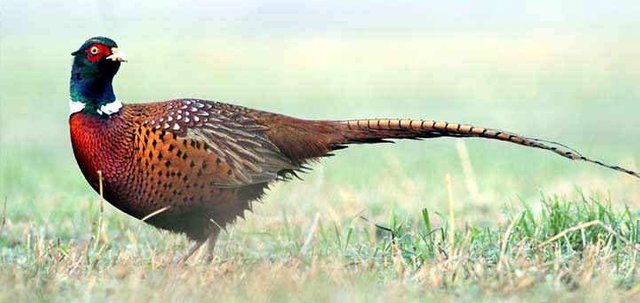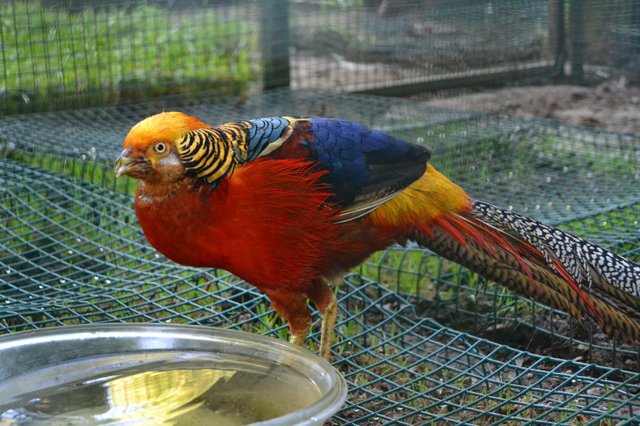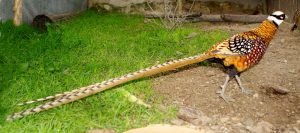Speaking of birds (Monday): The Faisan by @ nashilda17
image credit

The pheasant is a bird belonging to the Phasianidae family. Its scientific name is Phasianus colchicu. It looks a little like the chicken, but its plumage is more exotic and its silhouette more stylized.
In gastronomy it is highly valued due to the delicacy and softness of its meat, and the low levels of fat and cholesterol that it contributes to the organism.
Characteristics of the Pheasant
It feeds on animal and vegetable matter. It prefers seeds, fruits, leaves, as well as birds and small mammals such as lizards and snakes, among others.
The sexual dimorphism of the pheasant is evident. The male can reach 90 centimeters (cm) in height and have 1.2 kilograms (kg) on average, while the female usually reaches 63 cm in height and 0.9 kg.
The hue of their feathers also differentiates them. Hers are brown, while hers are bright, with shades of red, brown, blue, green or yellow. In some cases it can present black spots. Both genders have gray legs.
The head is small, proportional to your body. Its beak is arched and strong. The tail, long and thin, consists of 16 to 18 feathers. The wings are wide, short and rounded. It flies vertically and can reach 10 meters high in a few seconds, being able to escape very quickly in times of risk.
From the different species of pheasant I present to you:
The golden pheasant:
image credit

Is a native species of central China and western and is characterized by the long and bright plumage. It feeds on berries, seeds and insects. Its flights are short and due to its powerful wings it can take off from the ground, almost vertical.
Revered Faisan:
image credit
It is a bird from the center and west of China, the main feature of this bird is its long tail reaching more than 1.5 meters long.
Their sexual development is precocious because at one year of age they are already suitable for reproduction. The male is polygamous and in captivity they can reach between 20 and 50 eggs which hatch after 24 days of incubation. The pheasants are vivacious and aggressive and their breeding is necessary separately from other species.
As adults, they are often distrustful and scary, so they must have a wide space for their upbringing (Not suitable for beginners).
On reproduction I say:
The reproduction of the pheasant takes place in spring, since it is a bird that requires a lot of sun during its first days of life for its development, that is, it is photosensitive.
It regularly makes its nest in the ground, in the vicinity of the extensive cereal crops. You can put between 8 and 12 eggs, with the particularity that you place one every two days, while the incubation extends between 22 and 24 days.
The males practice polygyny, which is why they are accompanied by a harem of females. Each male pheasant can have between 6 and 10 pairs. It is normal for them to fight each other for possession and control of them.
In cases where the clutch can be destroyed, they usually make a second set, but with a smaller number of eggs compared to the first one. In these particular events, the incubation can last between 23 and 26 days.
The pheasants drink, after they hatch, they stay with their mother, until ten days, they already manage to jump to the trees, but they stay with the mother for about 6 months, for three to four months they begin to change their plumage and the one where they define their sex.
Remembering the characteristics, because the male is colorful while the female is brown.
When the pheasants are two years old, they are ready to lay eggs.
These birds, have a rapid growth but its process to celar takes a little longer.
Enjoy this video related to the mating of the pheasants.
3172/5000
Breeding
The upbringing of these birds is of the utmost importance, for undoubtedly, as we have already seen, they have a peculiar diet.
It should be noted that the time of breeding begins when the mother is in heat, as we have mentioned before, although for the month of December these birds begin to be in heat until the months of February and March.
And that's where the breeding of them begins.
It is important to take into account that if you want to have these birds at home for economic production or otherwise, there will be large and clean places because it is not fair to have these birds caged with much quantity.
If the person wants to have them in cages it is recommended that they only put them in cages when you are starting the heat process, since keeping an animal of this type enclosed is a bit sad and disconsolate.
But if it is your case, I recommend that the space be totally spacious and clean and when the female's heat time begins, place them in large cages where they can walk widely.
Place in a cage of three to four and five female pheasants with a male, so you avoid fighting each other.
Well, as I mentioned before, the males fight over the female to be able to step on them.
It is important that for each male that number of females be placed, because the less amount of female the more fertile the eggs will be.
Now the cage and the number of pheasants together is of utmost importance but another aspect that should be taken into account is incubation.
Normally when the female of the common pheasant lays the egg, it should be left about a day in the nest, taking great care that the female does not eat the egg, as this usually happens in these species or in animals too.
When this happens it is advisable to have an incubator on hand in a safe place with the necessary heat for the eggs.
Remembering that the eggs need to be incubated between 22 to 27 days, when these pheasant eggs are ready and bright are ideal to put in incubator, because if they are stained and not so bright they are not fertile.
The idea of this is to have the most fertile eggs, to achieve a broad production.
It is important not to remove the eggs or chicks from their mothers because as I mentioned before these after six months is that they are independent from their mothers.
Now another of the things that must be taken into account is the feeding of these birds, must be nutritious, and quality to avoid losing them, highlighting that vitamins and calcium is of utmost importance for the female before during and after laying the eggs.
It is important that if you have birds of other species should not be allowed to mix as a precaution and care of race.
Another aspect that should be taken into account is the cleanliness in breeding environments.
Well no doubt this is a bird that by its circumstances is robust, but like any other must have health care, of great importance because when they are in pregnancy must be more careful.
Rodents, curious animals by smells can approach and contaminate the environment, so that this does not happen should be cleaned constantly with insecticides, disinfectants, and keep the cages or care home very clean.
Not only should it be for protection of the birds, also, it should be done for personal hygienic care, since the birds and animals are not to live clearly with them and it is obvious that when they are in the process of birth you should be more with them.
It is very important that if the person wishes to breed these birds, have a wide place, but it is best to be in forests with warm environments, and if these birds are kept in cages, they are spacious and if they can have parts of nature And straw will be much better.